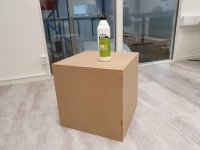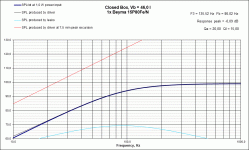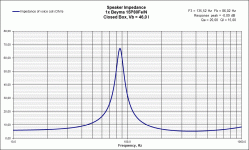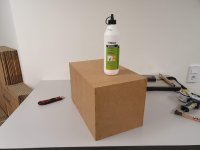No one can tell you how it will sound, the right filter will sound good the wrong one will sound badWow, that's a whole lotta taps!I'm starting to get the general idea now.
The most important question is, how will it sound...?Does the amount of filtering and use of taps degrade e.g. transients? Any other negative effects?
Using more taps will not make anything sound worse in of itself, more taps generally means a longer filter with more latency.
An FIR filter can introduce pre-ringing, it is usually not an audible problem but it needs to be considered. Latency and computational resources are the other possible downsides.
This is what pos the author of rephase said recently, quoted to avoid paraphrasing as it's relevant to your question
I think the IIR vs FIR is not only a matter of phase or delay, but more a matter of (CPU/DSP) power and limitations.
As a matter of fact FIR can do *everything* IIR can, including zero delay minimum-phase corrections (with time domain convolution at least), with zero drawback (beside power, but this is relative when you see the power consumption of an openDRC for example).
Yes, you can do FIR correction with zero delay (that is what I am currently running on my speakers).
And of course FIR can also do things IIR cannot do like linear-phase corrections, or very complex (or steep) corrections that would imply a great number of biquads (which brings complications I will cover in the next paragraph), or even purely temporal corrections (reflection cancellation, reverb, etc.).
And this brings another point where FIR is at an advantage compared to IIR: quantization errors.
IIR biquad implementations do generate errors because of the recursive nature of the filter scheme.
Even high precision implementations will generate quantification noises if the Q is high enough and/or the frequency low enough (ie long ringing, implying more accumulated errors). The level of this noise depends on the precision of the calculations, but the more filters you add the more noise you get, and this kind of noise is not as easily masked as harmonic distortion and the like (eg a single LF tone can generate a fullband noise).
In contrast FIR convolution is a direct calculation (even in its frequency domain form), does not depend on the correction itself, and not prone to errors. Errors will also not accumulate when adding multiple filter points. You can use thousands of EQ points in a FIR correction without increasing errors.
One last advantage of FIR vs IIR is correction portability: when importing a correction from one IIR crossover unit (or software) to another you never really know what you will get: filter conventions might vary (constant Q vs proportional Q, fc position for shelving, etc.), as well as their technical implementation (frequency response differences depending on sampling frequency in the UHF, as well as many strange behaviors).
FIR on the other hand is very predictable: once you have designed a correction (using rephase or another FIR tool) you can implement it in any convolution engine and get a predictable result based on the number of taps at hand.
This is an often overlooked point, but major nonetheless as many people are using corrections made for a given processor in another, and get frequency response variations that they often associate with audio qualities or defects of a unit, whereas it is "only" a difference in transfert function.
In short, if you have the processing power FIR only has advantages compared to IIR
Very nice illustrative charts Dynaudio4way !
I think the good news, in terms of the number of taps needed to make the corrections that we want, is that it is usually much lower than it might at first appear.
The reason being, 'How much correction do we actually want'?
I've found through many, many, on and off axis measurements outdoors , and at varying distances, that it's really easy to over-correct.
All we want to correct ime/imo, are frequency and phase anomolies that can measured and appear pretty much everywhere in quasi-anechoic conditions.
And it never pays to correct reflections or reverb, unless the goal is to tune to a very tight specific location.
This means too much frequency-resolution doesn't help. I've found smoothing often needs to be applied to corrections, when it would appear there are insufficient tap counts.
I've kinda come to adhere to the 500 taps at 500Hz rule of thumb, for the level of correction that works for appropriate measurements..
Double the number of taps needed for each octave decrease, halve it for each octave increase. (This was for 48kHz sample rate...double everything for 96kHz)
fwiw
I think the good news, in terms of the number of taps needed to make the corrections that we want, is that it is usually much lower than it might at first appear.
The reason being, 'How much correction do we actually want'?
I've found through many, many, on and off axis measurements outdoors , and at varying distances, that it's really easy to over-correct.
All we want to correct ime/imo, are frequency and phase anomolies that can measured and appear pretty much everywhere in quasi-anechoic conditions.
And it never pays to correct reflections or reverb, unless the goal is to tune to a very tight specific location.
This means too much frequency-resolution doesn't help. I've found smoothing often needs to be applied to corrections, when it would appear there are insufficient tap counts.
I've kinda come to adhere to the 500 taps at 500Hz rule of thumb, for the level of correction that works for appropriate measurements..
Double the number of taps needed for each octave decrease, halve it for each octave increase. (This was for 48kHz sample rate...double everything for 96kHz)
fwiw
Amp question:
Since I already have 2 pcs First Watt M2's and a Crown XLS 1002. Which configuration would be better?
1. Crown on 21", M2 on 15", M2 on 8" and a Pass Amp Camp Amp 1.6 (build one) on the TPL's?
Does the M2 have enough power to get the best out of the 15" in Q 0,5 sealed enclosures that will be boosted around 6 dB at 100 Hz? The 15" will be hooked up in parallel so around 4Ω.
2. Crown on 21", Crown (buy one) on 15", M2 on 8" and M2 on the TPL's?
Would a Crown mess up the sound quality on the 15"? I don't really like the idea of using a cheapo class D amp as high as 200-300Hz when the other frequencies are class A Pass amps.
 Z
Z
Since I already have 2 pcs First Watt M2's and a Crown XLS 1002. Which configuration would be better?
1. Crown on 21", M2 on 15", M2 on 8" and a Pass Amp Camp Amp 1.6 (build one) on the TPL's?
Does the M2 have enough power to get the best out of the 15" in Q 0,5 sealed enclosures that will be boosted around 6 dB at 100 Hz? The 15" will be hooked up in parallel so around 4Ω.
2. Crown on 21", Crown (buy one) on 15", M2 on 8" and M2 on the TPL's?
Would a Crown mess up the sound quality on the 15"? I don't really like the idea of using a cheapo class D amp as high as 200-300Hz when the other frequencies are class A Pass amps.
^^ Amps are incredibly overrated in the effects on final system performance in an active system. They will be driving as close to as flat an impedance as possible (providing you've designed the system well), and at low power because of the efficiency so don't obsess over them. There are plenty of other things that will have a far greater audible effect.
If you want something sensible to drive your double 21" subs per side, and your 15" woofers too...
(those big woofers will really benefit from an amp with a high damping factor over 500 preferably, and obviously enough headroom / sheer power to still deliver the bass SPL you want down to 20Hz after your corrective EQ has been applied)
… then I'd recommend the Matrix XT6004EQ if you have a srong preference for class AB sonic quality, which you can then use for other purposes occasionally as well.
Otherwise there's numerous options which are mostly class D types, of which these few below are some of the most likely contenders if you choosing value based on particular criteria with respect to a tight budget, ie. most watts for the money, best damping factor for the money, best sonic quality and watts for the money (Matrix XT) or other added features like LCD screen important too (PKN is great), or famous reliable brand (Crown have a lot of good stuff on the 2nd hand market) - otherwise if cost is no object just buy Powersoft.
Remember amplifier budgeting wisdom is not the total price paid, but the relative cost per watt per channel value you're actually getting.
Matrix XT6004EQ … £1962 total = £0.55 per watt per channel
2U rack, Class AB, 4x channel, 900Wrms per channel 8 ohm, damping factor 650
PKN XE10000 … £1900 total = £0.37 per watt per channel
1U rack, Class D, 2x channel, 2600Wrms per channel 8 ohm, damping factor 700
CVR D2004 … £1299 total = £0.16 per watt per channel
1U rack, Class D, 4x channel, 2000Wrms per channel 8 ohm, damping factor 5000
Bishop Sound BP10Q (Lab Gruppen clone) … £999 total = £0.19 per watt per channel
2U rack, Class TD, 4x channel, 1300Wrms per channel 8 ohm, damping factor 800
Crown I-Tech I-T4000 … £900 approx (ebay used) = £0.34 per watt per channel
2U rack, Class I, 2x channel, 1250Wrms per channel 8 ohm, damping factor 5000
Crown MacroTech 3600VZ … £800 approx (ebay used) = £0.31 per watt per channel
2U rack, Class I, 2x channel, 1120Wrms per channel 8 ohm, damping factor 1000
Thomann T-Amp TSA 4-1300 … £417 total = £0.09 per watt per channel
2U rack, Class H, 4x channel, 1220Wrms per channel 8 ohm, damping factor 200
(those big woofers will really benefit from an amp with a high damping factor over 500 preferably, and obviously enough headroom / sheer power to still deliver the bass SPL you want down to 20Hz after your corrective EQ has been applied)
… then I'd recommend the Matrix XT6004EQ if you have a srong preference for class AB sonic quality, which you can then use for other purposes occasionally as well.
Otherwise there's numerous options which are mostly class D types, of which these few below are some of the most likely contenders if you choosing value based on particular criteria with respect to a tight budget, ie. most watts for the money, best damping factor for the money, best sonic quality and watts for the money (Matrix XT) or other added features like LCD screen important too (PKN is great), or famous reliable brand (Crown have a lot of good stuff on the 2nd hand market) - otherwise if cost is no object just buy Powersoft.
Remember amplifier budgeting wisdom is not the total price paid, but the relative cost per watt per channel value you're actually getting.
Matrix XT6004EQ … £1962 total = £0.55 per watt per channel
2U rack, Class AB, 4x channel, 900Wrms per channel 8 ohm, damping factor 650
PKN XE10000 … £1900 total = £0.37 per watt per channel
1U rack, Class D, 2x channel, 2600Wrms per channel 8 ohm, damping factor 700
CVR D2004 … £1299 total = £0.16 per watt per channel
1U rack, Class D, 4x channel, 2000Wrms per channel 8 ohm, damping factor 5000
Bishop Sound BP10Q (Lab Gruppen clone) … £999 total = £0.19 per watt per channel
2U rack, Class TD, 4x channel, 1300Wrms per channel 8 ohm, damping factor 800
Crown I-Tech I-T4000 … £900 approx (ebay used) = £0.34 per watt per channel
2U rack, Class I, 2x channel, 1250Wrms per channel 8 ohm, damping factor 5000
Crown MacroTech 3600VZ … £800 approx (ebay used) = £0.31 per watt per channel
2U rack, Class I, 2x channel, 1120Wrms per channel 8 ohm, damping factor 1000
Thomann T-Amp TSA 4-1300 … £417 total = £0.09 per watt per channel
2U rack, Class H, 4x channel, 1220Wrms per channel 8 ohm, damping factor 200
And what's the real world DF as seen by the driver with a few m of connecting cable with different amp DFs? It's an irrelevant spec.those big woofers will really benefit from an amp with a high damping factor over 500 preferably
Amp question:
Does the M2 have enough power to get the best out of the 15" in Q 0,5 sealed enclosures that will be boosted around 6 dB at 100 Hz? The 15" will be hooked up in parallel so around 4Ω
Z
You need to run a simulation of the driver in the enclosure type and size that you plan to use. That will give you an idea of the power needed to reach your desired spl level. Most 15" pro woofers are quite sensitive and if you put them in a big enough box you shouldn't need much power to get them very loud. Try Jeff Bagby's woofer simulator spreadsheet as that allows some EQ options to be added into the simulation. The sim will give you a better idea of the impedance vs frequency to see if it is compatible with your amps at the power you want to draw from them. If you will be listening in a big space with a long distance to the speakers you will need much more power to get to the same spl as you would closer in a smaller room.
It's never a problem to have more power on tap than you need
The only Class D amps I have owned and heard are Hypex Ucd. They were very good amps but there was something about the higher frequencies that I did not like as much as with Class A/B. I would have no problem with using them at 200-300Hz though.
Just a little caution here. You are very likely to experience noise problems with the DA8.
The DA8 is an ok device, but the output is a little noisy, so it has a slight hiss with 90dB sensitive drivers and 16dB gain on the power amp. With a Crown amp and 100dB sensitive drivers, the hiss will be very noticable.
You will be much better off withva NanoDigi and 4 external dacs.
Johan-Kr
The DA8 is an ok device, but the output is a little noisy, so it has a slight hiss with 90dB sensitive drivers and 16dB gain on the power amp. With a Crown amp and 100dB sensitive drivers, the hiss will be very noticable.
You will be much better off withva NanoDigi and 4 external dacs.
Johan-Kr
Do you have a suggestion for something decent, not expensive and easy to implement with the NanoDigi now they don't sell the Curryman?You will be much better off withva NanoDigi and 4 external dacs.
Second test box glued. This is for one of the 15" midwoofers.
43 x 43 x 43 cm. 30 mm MDF, internal volume 50.65L. This will result in a net volume of about 46L. 2 per side, one 15" in each. Simulations below with Qtc 0,486 show that we are about 5dB down at 100Hz.
Since the crossover between 21" and 15" will be at 80Hz, I think this might work. Question is, what amp will do the job best. Time will tell



43 x 43 x 43 cm. 30 mm MDF, internal volume 50.65L. This will result in a net volume of about 46L. 2 per side, one 15" in each. Simulations below with Qtc 0,486 show that we are about 5dB down at 100Hz.
Since the crossover between 21" and 15" will be at 80Hz, I think this might work. Question is, what amp will do the job best. Time will tell




Question 
I'm thinking about changing direction in this build and take the boxes out of the equation completely!
What about building Open Baffle midbass and midrange?
Would that work with these drivers?
The low octaves (21") are already up and running in my IB so that works, check.
80 - 300 Hz in an open baffle with 2 x Beyma 15P80Fe/N, what would the baffle need to be in width? Height? I've not had the time to read up on that yet (OB noob) so I'm just throwing this question out there to see if some OB specialist might answer...
The speakers will stand about 100 - 120 cm from the front wall, side walls are meters away.
From 300 Hz upwards should be alright in any baffle width...
Or... maybe no baffle needed at all? Just attach the drivers to something sturdy and be done with it.
I'm thinking about changing direction in this build and take the boxes out of the equation completely!
What about building Open Baffle midbass and midrange?
Would that work with these drivers?
The low octaves (21") are already up and running in my IB so that works, check.
80 - 300 Hz in an open baffle with 2 x Beyma 15P80Fe/N, what would the baffle need to be in width? Height? I've not had the time to read up on that yet (OB noob) so I'm just throwing this question out there to see if some OB specialist might answer...
The speakers will stand about 100 - 120 cm from the front wall, side walls are meters away.
From 300 Hz upwards should be alright in any baffle width...
Or... maybe no baffle needed at all? Just attach the drivers to something sturdy and be done with it.
Question
I'm thinking about changing direction in this build and take the boxes out of the equation completely!
What about building Open Baffle midbass and midrange?
Would that work with these drivers?
The low octaves (21") are already up and running in my IB so that works, check.
80 - 300 Hz in an open baffle with 2 x Beyma 15P80Fe/N, what would the baffle need to be in width? Height? I've not had the time to read up on that yet (OB noob) so I'm just throwing this question out there to see if some OB specialist might answer...
The speakers will stand about 100 - 120 cm from the front wall, side walls are meters away.
From 300 Hz upwards should be alright in any baffle width...
Or... maybe no baffle needed at all? Just attach the drivers to something sturdy and be done with it.
Consider this: 80Hz is a 14 foot wavelength. Just how is it, a limited baffle size could support such a wave? Then there's the question of the negative phase back wave meeting your positive pressure wave from the infinite baffle bass. There will be some overlap at and near the crossover point.
I already built an exotic 4 way system, including infinite baffle bass. Never, even for a microsecond, did I consider anything termed, "open baffle".
Same. I'm 2x21, 2x15 and Unity/ch.Never, even for a microsecond, did I consider anything termed, "open baffle".
Never heard an OB/omni I even remotely liked, so be sure you hear one you love first. It's also not as easy to get right as you think and you need to be able to have the speakers well off the front wall to work well.
I have no experience of OB speakers so maybe I shouldn't respond at all but as your room is as large as L 14,5 x W 5,5 m (L 47,5' x W 15,8'), you should have more room distances to "play around with" than many others. Where you want / need to place your sofa should have an impact too of course.
ps if you show up the DIY meeting in Mölnlycke April 4-5, you could ask / get some advice about OBs from Solhaga. He used to have 3x15" / channel (AE's TD15) as OB-speakers. (His new giant AMTs are something really extra ...) HiFiForum.nu - DIY-träff 4 & 5 april i Mölnlycke - utställare
ps if you show up the DIY meeting in Mölnlycke April 4-5, you could ask / get some advice about OBs from Solhaga. He used to have 3x15" / channel (AE's TD15) as OB-speakers. (His new giant AMTs are something really extra ...) HiFiForum.nu - DIY-träff 4 & 5 april i Mölnlycke - utställare
Last edited:
I already built an exotic 4 way system, including infinite baffle bass. Never, even for a microsecond, did I consider anything termed, "open baffle".
After some studies I understand that it's not that easy to get an OB right.
Care to tell me more about your exotic 4 way system?
Same. I'm 2x21, 2x15 and Unity/ch.
Never heard an OB/omni I even remotely liked, so be sure you hear one you love first. It's also not as easy to get right as you think and you need to be able to have the speakers well off the front wall to work well.
I have never listened properly to an OB so that would be a good place to start.
More info on your 2x21, 2x15 and Unity/ch?
ps if you show up the DIY meeting in Mölnlycke April 4-5, you could ask / get some advice about OBs from Solhaga. He used to have 3x15" / channel (AE's TD15) as OB-speakers. (His new giant AMTs are something really extra ...) HiFiForum.nu - DIY-träff 4 & 5 april i Mölnlycke - utställare
Thanks for the tip on DIY meeting. I have to check my calendar, seems interesting. I'm guessing you're going?
- Status
- This old topic is closed. If you want to reopen this topic, contact a moderator using the "Report Post" button.
- Home
- Loudspeakers
- Multi-Way
- 4-way with dual 21", dual 15" & dual 8" + TPL-150. An IBWWMTM...

